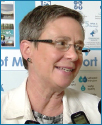A Message from the Executive Director

2016 was a milestone year for the Gulf Research Program (GRP) and we moved forward in significant ways. We offered a total of five grant opportunities, including three entirely new types of grants aimed at new audiences. For instance, our new Capacity Building Grants were designed specifically to provide support to science-focused nonprofits and community organizations to promote the understanding and use of science to serve community needs. In addition, our new Research-Practice Grants were designed to encourage engagement and collaboration among scientists, practitioners, and decision makers on research that will address a practical need. Both are part of our commitment to foster research that is truly useful to the people of the Gulf region and the nation.
We also increased the number of fellows funded. The Early-Career Research Fellows increased from 8 to 10 and the Science Policy Fellows increased from 4 to 10. We even doubled the number of Christine Mirzayan Science and Technology Policy Fellows we host in our Washington, DC, office from the traditional 1 to 2, which allowed us to have both an ecologist and an anthropologist onboard to bring us disciplinary diversity.
In addition, we initiated three new consensus studies and two workshops that will advance knowledge and inform our future funding opportunities. One important highlight is a study the GRP is leading, Advancing Understanding of Gulf of Mexico Loop Current Dynamics. The National Academies appointed an independent group of 14 members to compile a review of what we know and do not know and outline the research needed to better understand and predict the Loop Current. We believe this will provide important guidance for program funding investments in 2018 and beyond.
We also continued to improve in 2016. Lessons from early grant cycles have led to changes in our application questions and forms, efficiencies in how we conduct external peer review, and other changes we believe will, over time, make the GRP a model for efficient and science-friendly operations. We still need to diversify our audiences, however. Fellowship applications, for instance, still come primarily from the life and physical sciences and we seek more applicants from the social, behavioral, and health and medical sciences.
As the program continues to mature, it will evolve to tackle complex challenges that arise where energy systems, people, and ecosystems coexist. We look forward to continued interactions with stakeholders from research, government, industry, and nonprofit communities as we work on behalf of the National Academies to bring lasting benefits to the Gulf region and the nation.




